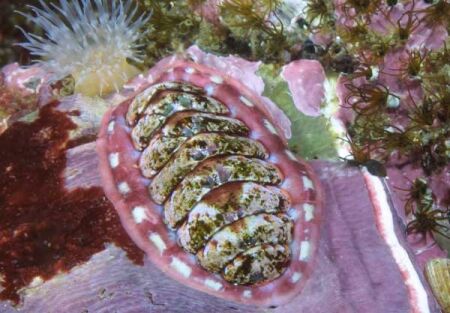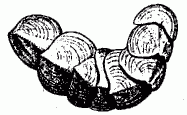
| Palaeos |  |
Polyplacophora |
| Mollusca | Polyplacophora |
| Page Back | Unit Up | Clade Up: Mollusca | Page Next |
| Unit Back | Clade Down: None | References | Unit Next |
|
Abbreviated Dendrogram
MOLLUSCA |--ACULIFERA | |--Phthipodochiton | `--+--+--Solenogastres | | `--Caudofoveata | `--POLYPLACOPHORA `--CONCHIFERA |
Contents
|
Taxa on This Page

image copyright © Keith Clements and Jon Gross Marine Life of the Northeast Pacific
Polyplacophorans, or chitons, are a class of persistently primitive marine mollusks commonly occurring on rocks and seaweed in the intertidal zone. A few species They have also been found at depths down to 5,000 meters. There are about 600 recent species
Chitons do not vary much in form. All have eight shell plates (although a Palaeozoic lineage, the Sempteochitonida, had seven), are generally oval in outline and have a flattened body, usually with the greatest thickness of about one-fourth their greatest width.
The chiton shell normally consists of eight, articulating calcareous valves with the joints between them running perpendicular to the axis of the body. These valves are constructed in such a way that the animal can often roll up when disturbed or removed from the rock. The parts of the shell are shown here

There is a creeping foot, a primitive feature in molluscs, and the radula is of the "docoglossan" type, like limpets (Patellogastropoda) and Tryblidiida. The radula are mineralized with magnetite (a compound of iron). The head is poorly developed, and visible only from the ventral side (again like the Tryblidiida). A band of muscular tissue, the girdle, runs along the dorsal periphery of the animal (see illustration above). The girdle commonly has embedded in it small calcareous spines, scales or spicules, not unlike the spicules of the very primitive and wormlike Caudofoveata and Solenogastre Aplacophora. Indeed, at one time the Aplacophora and Chitons were grouped in the same class, the Amphineura. However it is now known that there are many differences between these types of primitive molluscs, despite the shared primitive features (symplesiomorphies) that unite them.
Chitons lack normal molluscan sense organs like statocysts, cephalic eyes, and tentacles. The chief senses is a subradular organ and the "aesthetes". These latter, which among living molluscs are unique to chitons, are special mantle shells found within tiny vertical canals in the upper tegmentum (upper shell layer) [Barnes 1980 p.386]. Interestingly, very similar canals are found in the shell of Tryblidium reticulatum (Silurian period, family Tryblidiidae, Tryblidiida) [Knight and Yochelson 1960 p.77], although they are absent in the recent Neopilina (presumably lost when the animal migrated to deep water). The aesthetes are supplemented by tactile and photoreceptor cells in the mantle and girdle. The animal is thus able to detect light, which it responds negatively to. These shy creatures only become active at night, when they creep over rocks scraping algae and other microscopuc organisms off the surface with their radula. Like limpets, the animal will often return to its resting place for the day.
Again as with the Tryblidiida, with which the chitons would seem to be related, the animal is metameric or pseudometameric, with repeated gills and shell muscles. This led to the view that these animals (and thus the Mollusca as a whole) evolved from a segmented annelid-like ancestor. However, analysis of chiton embryo, larval, and postlarval development and metamorphosis shows that the "segmented" or serial nature of the polyplacophoran shell musculature is a secondary condition, and an unsegmented ancestor at the base of molluscan evolution is more likely [Wanninger and Haszprunar 2001].

image © xxxx from Treatise on Invertebrate Paleontology. Part I. Mollusca 1., p.53
Fossil chiton specimens are almost always loose, disarticulated valves. They have been found in rocks of the Furongian onwards, but are rare, probably because chitons tend to occupy environments where the possibility of preservation is not high. There are about three extinct orders, mostly Palaeozoic.
Range: Silurian or Carboniferous to Recent
Phylogeny: Aculifera ::: polyphyletic Aplacophora + *
Characters: inhabit rocks and feed on algae in the intertidal zone. Elongate or oval and dorsoventrally flattened, shell of eight overlapping plates embedded in, and sometimes covered by tissue. They have a large, muscular, ventral foot and a poorly-differentiated head without eyes or tentacles. The mantle cavity is a groove around the foot, with 6-88 pairs of ctenidia, which together with the overlapping plates, gives it a segmented appearance. The animals feed with a radula, and the anus is subterminal. The sexes are separate and most taxa have larval stages. - Jack R. Holt
Comments: here used as synonymous with Neoloricates, which date from either the Silurian or Carboniferous. The status of Paleoloricates is sometimes ambiguous, as many taxa are stem or basal aculiferan. MAK120612
Links Polyplacophora introduction to the group - gives a comprehensive list of orders, families and genera, but no other information as yet other than a reference for each, the reference gives the author and year and page number, but no link to a bibliography (the menu without frames here); Class Polyplacophora - short intro with some images - Animal Diversity Web; Polyplacophora - the Chitons! - intro; Mollusca - Class Polyplacophora - short intro; Class Polyplacophora (The Chitons or Coat-of Mail Shells) - more on chitons
| Page Back | Unit Home | Page Top | Page Next |
page uploaded 29 September 2002, last modified 28 December, page by M. Alan Kazlev
reformatted and moved ATW051013, checked ATW050731, last modified MAK120612 Creative Commons Attribution